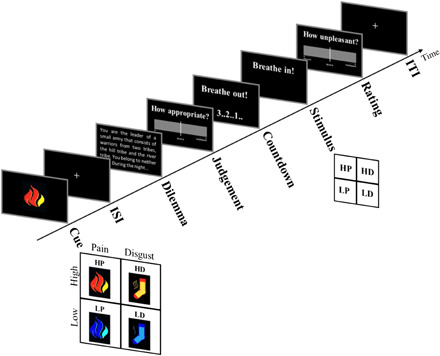Fig. 1. Experimental design.

Each trial began with a pictorial cue predicting either a pain or disgust stimulation. After a variable interstimulus interval (ISI), participants had to read a dilemma and judge a presented course of action on a continuous visual analog scale (VAS) of appropriateness (from extremely inappropriate to extremely appropriate). Next, participants were instructed to slowly breathe out during a countdown period. Then, a breathe in instruction appeared together with the stimulus delivery, which could be either olfactory or thermal. Consequently, participants rated the unpleasantness associated with the stimulus on a VAS (from extremely unpleasant to extremely pleasant), which was followed by an empty intertrial interval (ITI). Four different kinds of predictive cues were presented, indicating the unpleasantness (high/low) and modality (pain/disgust) of the upcoming stimulation (thermal pain/olfactory disgust). Please see Materials and Methods for details about duration and number of trials in each condition of experiments 1 and 2.
